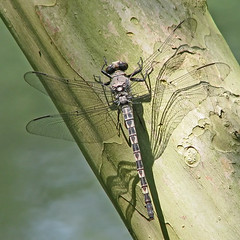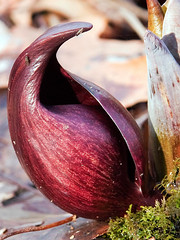Plants and Animals
Learn More
Other Websites
Explore this page
Plants
Most times of the year, the Red Maple Seepage Swamp can look quite sparse, with only widely scattered ferns. But in spring and early summer, skunk-cabbage transforms the community into a vivid green “cabbage patch.” In early spring, look for skunk-cabbage’s leathery maroon, sometimes streaked, spiral sculpted “hood” (spathe) emerging just a few inches out of these groundwater-charged seeps.1 Two-foot-long stalked green leaves unfurl as spring progresses, and the swamp is replete with what looks like super-sized loose-leaf cabbages. Although skunk-cabbage predominates in these habitats until mid-summer, it goes dormant quickly. Its above-ground parts do not turn brown and crisp, but essentially “dissolve” with the onset of peak summer temperatures. It may not be visible at all by July or early August. Ecobit: Skunk-Cabbage and Groundwater: A Unique and Timeless Relationship
- 1. . 2000. Skunk cabbage (Symplocarpus foetidus).
Canopy Trees
The trees whose crowns intercept most of the sunlight in a forest stand. The uppermost layer of a forest.
- green ash
- red maple
- American beech (occasional)
- American hornbeam (occasional)
- American sycamore (occasional)
- box-elder (occasional)
- northern red oak (occasional)
- tuliptree (occasional)
Although often an understory tree in other natural communities, red maples may be dominant in the canopy of the Red Maple Seepage Swamp. Their leaves can blaze red or bright yellow in fall. Green ash is another frequent canopy tree in this natural community. American beech and tuliptree often grow on slightly elevated and better drained ground within the community.
Understory Trees
Small trees and young specimens of large trees growing beneath the canopy trees. Also called the subcanopy.
Red maples and green ash also make up the understory as well as the canopy in this community.
Shrubs, Saplings, and Vines
Shrubs, juvenile trees and vines at the right height to give birds and others a perch up off the ground but below the trees.
- blackhaw
- common winterberry
- northern spicebush
- southern arrow-wood
- swamp azalea
- American holly (occasional)
- bitternut hickory (occasional)
- eastern poison-ivy (occasional)
- roundleaf greenbrier (occasional)
- silky dogwood (occasional)
- Virginia creeper (occasional)
Look for the white, fragrant blooms of swamp azalea in spring, and the glossy red berries of common winterberry from fall to winter.
Low Plants (Field Layer)
Plants growing low to the ground. This includes small shrubs and tree seedlings.
- cinnamon fern
- orange jewelweed
- skunk-cabbage
- American golden-saxifrage (occasional)
- Canadian clearweed (occasional)
- cardinal flower (occasional)
- crested woodfern (occasional)
- drooping sedge (occasional)
- fowl mannagrass (occasional)
- golden ragwort (occasional)
- halberd-leaf tearthumb (occasional)
- Jack-in-the-pulpit (occasional)
- marsh seedbox (occasional)
- monkeyflowers (Mimulus spp.) (occasional)
- sensitive fern (occasional)
- small-spike false nettle (occasional)
- spotted water-hemlock (occasional)
- white avens (occasional)
- whitegrass (occasional)
The defining plant in this natural community is skunk-cabbage, noticeably carpeting the Red Maple Seepage Swamp from late winter until mid-summer.
Orange jewelweed blooms in July, then sports seed capsules in August—when you touch them, the capsules will pop open and launch the seeds out, giving the plant another nickname, “touch-me-not.”
Cinnamon fern—tall, with rust-colored hairs along its robust fronds—is often visible here over the entire growing season. So is sensitive fern—lower-growing, with scalloped edges.
Non-Native Invasive Plant Species
Read about non-native invasive plants that threaten this natural community in Ecological Threats.
Animals
Because it’s so wet, the Red Maple Seepage Swamp can provide important habitat for amphibians—frogs, toads, and salamanders.
 Gray petaltails (Tachopteryx thoreyi) are large (3 inches long), uncommon dragonflies in D.C.
Gray petaltails (Tachopteryx thoreyi) are large (3 inches long), uncommon dragonflies in D.C.
Photographer: Vicki DeLoacheIt is also the right habitat for a dragonfly that is special for its wide-set eyes—the gray petaltail, which is considered rare in Maryland. The three-inch long adults, black and gray with delicate translucent wings, can be found around seepage swamps from mid-June to mid-August, perching vertically on tree trunks (or on people wearing neutral colors!). It is the only eastern dragonfly whose young larvae live buried in the mud instead of water. Both adults and their larvae are important friends to visitors of seepage swamps: adult gray petaltails feed on adult mosquitoes, and their mud-dwelling larvae feed on mosquito larvae.1 This dragonfly has not yet been documented at Rock Creek Park. If you see it, report it to the Rock Creek Resource Manager!
Ecobit: An Extra Set of Eyes
 Skunk-cabbage flower (Symplocarpus foetidus) with pollinating flies.
Skunk-cabbage flower (Symplocarpus foetidus) with pollinating flies.
Photographer: Gary BrownellSkunk-cabbage’s warm “hood” offers shelter to invertebrate animals in late winter. While that may not seem very spectacular, it’s one strand in an intricate web of living relationships that keep nature going strong.



